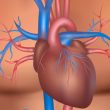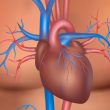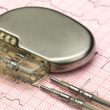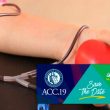Many patients arrive to the cath lab for a diagnostic coronary angiography after an echo showing severe ventricular dysfunction, even in asymptomatic patients. In many occasions, their coronary arteries are normal, and in many others, we find coronary disease that is not enough to warrant such severe ventricular dysfunction. Patients with heart failure are frequently...
Surprising EXCEL Outcomes in Diabetics with Main Left Stenosis
This study especially designed to compare PCI vs. CABG in patients with left main coronary artery disease and low to intermediate Syntax score showed that 30-day and 3 -year outcomes of PCI with everolimus eluting stents vs CABG were consistent both in diabetic and non-diabetic patients. The randomized EXCEL trial (Evaluation of XIENCE versus Coronary...
Promising Results for Tricuspid Repair
Courtesy of Dr. Carlos Fava. Tricuspid regurgitation (TR) is more common than we thought. Around 1.6 million people in the US and over 3 million in Europe experience significant TR. It usually has a functional cause and its negative impact on patient prognosis is strong. Its surgical treatment is challenging, and it is important that its resolution...
EXCEL Outcomes: PCI vs CABG in Patients with Prior Cerebrovascular disease
Most certainly, as we read this title, we imagine the conclusion (as does the editor): patients with prior cerebrovascular disease (CEVD) benefit from a less invasive revascularization strategy, such as PCI. However, the EXCEL outcomes tell us that patients with left main coronary artery disease (LMCAD) and a history of CEVD will not benefit from...
The Most Read Articles of March in Interventional Cardiology
1- What to Do with Blood Pressure Levels Between 130/80 and 139/89 mmHg The decision to be made with a treatment-free patient with systolic blood pressure over 160 mmHg or diastolic blood pressure over 100 mmHg is an easy one. All guidelines agree: treatment should be started immediately alongside lifestyle changes. Read more 2-...
New Device for More Protection in Carotid Artery Stenting
This new “Paladin” system for post-dilation during carotid artery stenting was safe and may effectively reduce the number of particles that reach the brain, with a subsequent decreased risk for peri-procedural stroke. This study evaluated the safety and efficacy of the Paladin System, a novel post-dilation balloon with an integrated distal protection filter designed to...
Modern Valves Reduce the Need for a Pacemaker
Courtesy of Dr. Carlos Fava. Transcatheter aortic valve replacement (TAVR) has already demonstrated benefit for different risk groups, but one of the remaining challenges is the reduction of the need for a pacemaker, which is still high for self-expanding valves compared with expandable balloons. The study enrolled 203 patients with severe aortic stenosis who underwent TAVR with...
Balancing Bleeding Risk vs. Thrombotic Risk to Define Dual Antiplatelet Therapy Duration
Patients who undergo complex angioplasty are at higher ischemic risk, but only benefit from extended dual antiplatelet therapy if there are no factors for high bleeding risk. These data suggest that the bleeding risk must weigh more than the ischemic risk on the determination of dual antiplatelet therapy duration. Complex angioplasty is associated with higher...
Paladin: New Carotid Protection System with Good Results
Courtesy of Dr. Carlos Fava. Carotid artery stenting (CAS) with a cerebral protection system has emerged as an alternative to surgery, particularly for patients with high surgical risk. Nowadays, there are a considerable number of cerebral protection systems, but these may sometimes fail due to anatomical issues, the diameter of embolized particles, or placement difficulties (among...
ACC 2019 | SAFARI: Unexpectedly, Radial Approach Offers No Benefits In STEMI
This study was not able to show benefits in terms of mortality or bleeding when using radial vs. femoral approach in patients undergoing ST elevation myocardial Infarction. This small trial does not change things for “radialists” way past their learning curve who already feel confident with this technique. For them, there is no way back....









